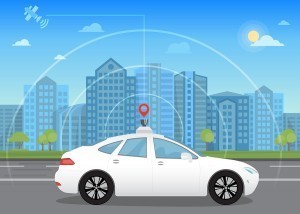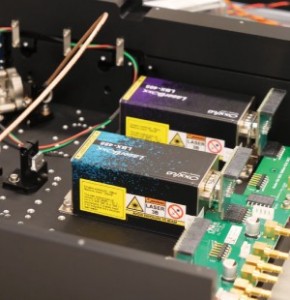
Lidar is a crucial piece of the autonomous car puzzle. Unfortunately, today’s technological limitations prevent it from being as fast, compact, affordable or reliable as it should be for real-world self-driving applications. Recent advancements may change that.
Self-driving cars rely on various sensors to navigate, but lidar is among the most important. It’s also one of the most complex and expensive, so few available cars today feature it. That could change as the technology becomes more reliable, accessible and versatile, letting autonomous vehicles finally have their moment. Here are six recent technological trends that could pave the way for that future.
Photonic integrated circuits
Photonic integrated circuits (PICs) are one of the most revolutionary technologies in photonics today. PICs are integrated computer chips like those powering everyday electronics, but instead of processing signals through electrons, they use light. While this technology isn’t exclusive to lidar, it has substantial implications for self-driving cars.
PICs process information at the speed of light, making them significantly faster than electronic circuits. They also increase bandwidth and are more efficient since photons flow within the circuit without losing energy. That makes them the ideal technology to support computationally intensive machine learning functions in a small space.
Fast, accurate AI decision-making is key to building safe self-driving cars. PICs provide the speed, bandwidth and efficiency necessary to run these complex algorithms in a form factor that fits most vehicles. Machines that can process more information in less time are far safer.
Lidar-on-a-chip
Similar advances in circuit technology are leading researchers toward building complete lidar-on-a-chip systems. These devices would do for autonomous vehicles what systems-on-a-chip (SoCs) did for consumer electronics.
Conventional lidar systems typically involve multiple components, making them bulky and expensive. As a result, integrating them into a car while keeping the end price accessible to the average driver poses a challenge. Lidar-on-a-chip solves that by using solid-state alternatives to traditional systems and putting everything on a single, small device.
In addition to being smaller, the solid-state technologies in lidar-on-a-chip are significantly faster than mechanical alternatives. Once they reach a full production scale, they can also cost just $10 per unit to manufacture. Self-driving cars will become more viable for a wider range of consumers as these options become commercially available.
Lidar-friendly paint
Some important automotive lidar advancements happen outside the realm of self-driving systems. It may initially seem unrelated, but car paint is a critical consideration for effective autonomous navigation. Lidar typically struggles to identify darker vehicles, as dark paint absorbs more light, leaving less to reflect and measure.
Future advancements in lidar systems will likely address this issue, but in the meantime, lidar-friendly paint has emerged as a helpful solution. These paints use coatings or pigments that reflect lidar-measurable wavelengths. As a result, drivers don’t have to choose between car color and safety.
Other innovations in car production push these benefits further. Mass finishing can save automakers money in manufacturing by preventing defects while preparing surfaces to adhere to these paints. In turn, lidar-friendly finishes become more accessible, improving safety for everyone on the road, even if they don’t have a self-driving car.
Back-emitting VCSELs
Vertical-cavity surface-emitting lasers (VCSELs) are another innovative step in lidar technology. VCSELs let lidar systems take on smaller form factors and are relatively easy to manufacture in large volumes. Those advantages have made them an increasingly popular choice for consumer electronics like newer lidar-capable iPhones, but they’re growing in automotive applications, too.
Up to now, automakers have used other lidar systems because VCSELs typically don’t provide the same performance as less compact alternatives. Back-emitting VCSELs change that. These new options reduce system complexity, enabling faster processing and shorter laser pulses.
Faster pulsing and processing means back-emitting VCSELs would perform better in self-driving vehicles. They’d become more reliable and powerful, ensuring automakers don’t have to sacrifice safety for ease of manufacturing. Reliable, affordable lidar systems would become a reality, opening the door to lower-cost autonomous cars.
FMCW lidar
Frequency-modulated continuous-wave (FMCW) technology — also called Doppler lidar or 4D lidar — is another important innovation. These systems use the Doppler effect to measure velocity, similar to how radar works.
Conventional, time-of-flight lidar measures velocity by calculating the difference between back-to-back distance measurements. The major downside to this approach is that it takes up valuable time and computing resources, which isn’t ideal in traffic, where immediate reactions are necessary. By contrast, FMCW lidar projects a continuous beam, and varying frequencies provide instantaneous readings on object velocity and direction.
FMCW lidar can classify objects five times faster than time-of-flight systems by removing the need for secondary calculations. That jump could be the difference between life and death in a high-speed crash scenario. It would also free computing resources for more accurate object recognition.
Bounce-flash lidar
Recognizing multiple objects at once is another common challenge for automotive lidar systems. Recent research suggests that bounce-flash lidar could overcome this issue. This technology borrows from the concept of bounce-flash photography, where photographers light their subjects indirectly by bouncing light off a nearby surface.
The indirect light from bounce-flashing lights a scene more evenly, reducing harsh glare and shadows. Applying the same concept to lidar means low-reflective or over-reflective surfaces don’t jeopardize the system’s accuracy. It also lets lidar systems “see” more objects in a single pass, as bounce-flashing illuminates an entire scene instead of a single point.
Bounce-flash technologies could help self-driving cars get a better contextual picture of where they are in traffic as they improve. These more conclusive scans would be particularly useful in high-traffic areas where vehicles must consider multiple moving objects.
Automotive lidar Is rapidly advancing
Fully autonomous cars may still be years away from being a reality, but these photonics breakthroughs bring that future closer. Automotive lidar will become smaller, cheaper, faster, and more reliable as researchers refine and implement these concepts.
Better lidar is essential to safe and accessible self-driving cars. Given that relationship, advancements in photonics technology ripple across industries, culminating in a new generation of transportation. The roads and everyone on them will be safer for it.































 Back to Features
Back to Features



























